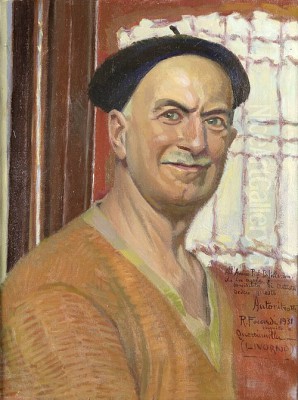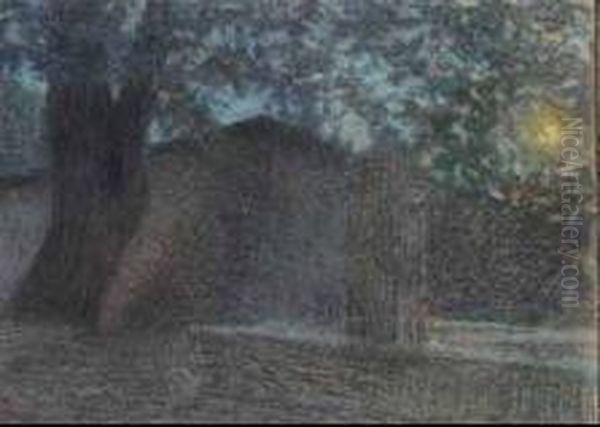
Ruggero Focardi (1864-1934) was a significant Italian painter born in the artistic heart of Florence. His life spanned a period of great change in Italy, both socially and artistically, and his work reflects the transition from the late 19th-century concerns with realism and light to the burgeoning Symbolist movement that explored deeper emotions and ideas. Focardi began his artistic journey with a notable period in London before establishing himself within the vibrant Florentine art scene, navigating the influential currents of the Macchiaioli and Divisionism.
#### Early Life and Artistic Beginnings
Born in Florence in 1864, Ruggero Focardi entered a world where artistic traditions were being challenged. Information suggests he initiated his professional career not in his native Italy, but in London, where he spent twelve formative years. This period abroad likely exposed him to different artistic trends and perspectives, although details of his activities there remain somewhat scarce in the provided summaries. Upon returning or establishing himself more firmly in Italy, his early work caught the attention of prominent figures.
An early painting, described as an emotionally profound scene, was instrumental in earning him the friendship and likely the mentorship of Telemaco Signorini. Signorini was a leading figure of the Macchiaioli movement, a group of Tuscan painters who reacted against academic conventions by emphasizing capturing the immediate impression of light and shadow through patches, or macchie, of colour. This connection places Focardi firmly within the orbit of this revolutionary Italian art movement from relatively early in his career.
#### Influence of the Macchiaioli
Focardi's initial artistic approach was deeply rooted in naturalism. He studied nature directly, and his technique involved a distinctive "spotted" brushwork. This method clearly shows the influence of the Macchiaioli. This group, active primarily in Florence from the 1850s onwards, included artists like Giovanni Fattori, Silvestro Lega, Adriano Cecioni, and Odoardo Borrani, alongside Telemaco Signorini. They sought to depict contemporary life and landscape with honesty and immediacy, often painting outdoors (en plein air) to capture the effects of natural light.

Focardi's adoption of a technique involving distinct brushstrokes, likely small dabs or patches of colour, aligns with the Macchiaioli's experimental approach to representing light and form. While perhaps not a core member in the movement's foundational years (given his birth date), his early style certainly absorbed their lessons, focusing on realistic depictions, often of rural or everyday life, rendered with attention to atmospheric effects. His friendship with Signorini underscores this connection and suggests an alignment with their anti-academic principles.
#### Transition Towards Divisionism and Symbolism
As his career progressed, Ruggero Focardi's style evolved. While maintaining his commitment to certain subjects, particularly landscapes and figures imbued with lyrical feeling, his technique shifted. He moved closer to the principles of Divisionism (or Divisionismo in Italian), a style related to French Neo-Impressionism (Pointillism) but with its own distinct Italian character, often infused with Symbolist aims. The provided text specifically mentions his style approaching the Symbolist Divisionism of Pietro Previati (though the more prominent Divisionist painter is usually cited as Gaetano Previati, the influence is clear).
Divisionism involved applying paint in separate dots or strokes of pure colour that were intended to mix in the viewer's eye, creating a more luminous effect than traditional colour mixing on the palette. Key Italian Divisionists included Giovanni Segantini, Giuseppe Pellizza da Volpedo, Angelo Morbelli, and Gaetano Previati. These artists often used the technique not just for optical effects but to convey emotional states, social commentary, or symbolic meanings. Focardi's later work embraced this direction, suggesting a move towards more subjective and evocative interpretations of his subjects.
#### Collaboration and Artistic Circles
Focardi was not an isolated figure. He actively engaged with his contemporaries. The sources mention a collaboration with the painter Plinio Nomellini. Nomellini was another significant artist associated with both the late Macchiaioli phase and, more prominently, with Italian Divisionism and Symbolism. Working with Nomellini would have undoubtedly reinforced Focardi's exploration of Divisionist techniques and Symbolist themes, as Nomellini's own work often featured vibrant colour and emotionally charged depictions of landscapes and labour.
His participation in the art world is further evidenced by his involvement in organizing the "Fiorentina Primaverile" (Florentine Spring) exhibition in 1922. This major event showcased contemporary Tuscan art. Focardi was part of the discussions and perhaps the selection committee alongside other notable artists like Raffaello Sorbi and Ruggero Panerai. This role indicates his respected position within the Florentine art community during the early 20th century.
#### Themes and Subject Matter
Throughout his stylistic evolution, Focardi remained dedicated to certain core themes. Landscape painting was a constant, likely focusing on the Tuscan countryside he knew so well. His works often depicted rural life, featuring peasants and scenes of daily labour. These subjects, initially treated with Macchiaioli-influenced naturalism, likely gained deeper, perhaps symbolic, resonance in his later Divisionist phase.
He was also drawn to "lyrical figure subjects," suggesting paintings that focused on human emotion and poetic interpretation rather than purely objective representation. Works like Maternal Smile point to an interest in intimate human moments. His dedication to these themes provided continuity across his career, even as his technical means of expression changed, reflecting a consistent interest in the human condition and the character of his native region.
#### Representative Works
Several key works help illustrate Ruggero Focardi's artistic output and recognition:
L'ultima ora del giorno (The Last Hour of the Day): Painted around 1920, this work is described as depicting three peasants returning home at day's end (one source says before dawn, another implies sunset - the title suggests the latter). This painting likely exemplifies his later Divisionist style, using fragmented colour to capture the specific light conditions and perhaps imbue the scene of weary labourers with a sense of pathos or timelessness characteristic of Symbolist leanings.
Il gioco della ruzzolone (The Game of the Ruzzolone): This earlier work, dated to 1895 (or exhibited 1889 in another mention), captures a traditional Tuscan game. It won the "Firenze" prize and was exhibited in Florence, indicating early success. Stylistically, it might represent his mature Macchiaioli-influenced phase or the beginnings of his transition, focusing on local customs and vibrant genre scenes. It was reportedly exhibited at the Florence Modern Art Museum.
Country Life (Vita Campagna): This painting achieved significant recognition by being purchased by King Umberto I of Italy (the source incorrectly mentions Urban V) for the Modern Art Museum (likely the Galleria Nazionale d'Arte Moderna in Rome, or possibly Florence's gallery). This royal patronage highlights Focardi's status. The title suggests a theme central to his oeuvre.
Maternal Smile (Sorriso materno): Exhibited at the Rome National Exhibition, this work points to his interest in intimate, figurative subjects with emotional content.
A Bridge over the Po and a Wounded Girl: Also shown at the Rome National Exhibition, this painting was acquired for the Biennale collection in Rome. The title suggests a narrative or allegorical element, potentially aligning with Symbolist trends.
The Peasants' Garden (L'orto dei contadini): Housed in the Modern Art Gallery of Parma, this work again underscores his focus on rural themes and everyday life.
Notturno (Nocturne): Mentioned as an early work (though dated 1864 in one source, likely referring to his birth year), it's noted for its delicate handling of nature, light, and shadow, characteristic of his formative naturalistic period.
Ante Occasus and Vita Campagna: These works received awards in the Barbiano and Lombardi competitions respectively, further attesting to the critical acclaim Focardi received during his career. There might be overlap between the awarded Vita Campagna and the one purchased by the King.
#### Fresco Work and Later Activities
Beyond easel painting, Focardi also undertook decorative projects. He is credited with painting frescoes in the ground floor hall of the Medici Villa at Cerreto Guidi. This commission, likely received due to his established reputation, allowed him to work on a larger scale and engage with the historical context of a significant Tuscan landmark. Such projects were common for successful artists of the period, integrating fine art with architectural spaces.
His continued participation in exhibitions, like the aforementioned Fiorentina Primaverile in 1922, shows his sustained activity well into the 20th century. He remained a relevant figure in the Italian art scene, bridging the gap between the 19th-century realist traditions and the newer currents that emerged around the turn of the century and afterwards, even as movements like Futurism, led by artists such as Giacomo Balla and Umberto Boccioni, were taking Italian art in radically different directions.
#### Artistic Context and Contemporaries
Focardi's career unfolded alongside many other important Italian artists. His early influence, Telemaco Signorini, connects him to the Macchiaioli generation including Giovanni Fattori and Silvestro Lega. His transition to Divisionism places him in dialogue with figures like Giovanni Segantini, Gaetano Previati, Plinio Nomellini, Angelo Morbelli, and Giuseppe Pellizza da Volpedo. His exhibition activities brought him into contact with contemporaries like Raffaello Sorbi and Ruggero Panerai.
While distinct from the more academic painters or the later avant-garde, Focardi shared the artistic landscape with figures known for portraiture like Antonio Mancini, or others exploring social themes. His work offers a specific Tuscan perspective within the broader panorama of Italian art, which was grappling with national identity, social change, and international artistic developments like Impressionism, Post-Impressionism, and Symbolism.
#### Legacy and Conclusion
Ruggero Focardi died in 1934. His artistic legacy lies in his skillful navigation between two major Italian art movements: the Macchiaioli-influenced naturalism of his early years and the Symbolist-infused Divisionism he adopted later. He remained consistently dedicated to depicting the landscapes and people of his native Tuscany, capturing both the external realities and the underlying emotional or poetic qualities of rural life.
His works, recognized through awards, royal patronage, and inclusion in significant museum collections, stand as testament to his talent and his contribution to Italian art at the turn of the 20th century. While perhaps not as internationally famous as some of his contemporaries, Focardi represents an important strand of Italian painting that sought to combine truth to nature with expressive colour and lyrical feeling, leaving behind a body of work that reflects the unique artistic climate of Florence and Tuscany during his lifetime. His art provides valuable insight into the transition from 19th-century realism towards the more subjective and experimental approaches of the early 20th century.